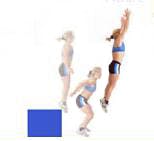Can plyometric jump training help prevent you from having knee hip and ankle injuries that are caused by dancing?
Lower extremity injuries for dancers are more often the result of an overuse syndrome than acute traumatic injury. However, both can be prevented with proper training. Dancing, like any sport, is competitive and becomes a year round activity. This takes a toll on the body. To keep your body healthy and in tip top shape an additional workout program may be necessary to prevent injuries.
Dance jump landing forces have been reported to be as high as 15.8 times body weight. In any dance class you may have an average of 200 jumps and in over half of them you will be landing on one leg. That is a lot of stress on your body.
Women dancers have been shown to be 20-30% weaker in thigh musculature than men dancers of like build and age. Combine this information with the knowledge that 89% of ACL injuries among women dancers are the result of landing from a jump, and you have a clear reason for dancers to incorporate jump training into their workout program.
Jump training involves the use of a technique called plyometrics. Plyometrics is defined as, “exercise involving repeated rapid stretching and contracting of muscles as by jumping and rebounding to increase muscle power.” One study found that plyometric training increased dancers vertical jump height 8.3%, leg press strength 37%, and aesthetic jump height 14%. Combined with weight training, plyometrics have been found to increase leg strength up to 90% and to delay the onset of muscle fatigue. A study conducted on volleyball players, showed that six weeks of plyometric training reduced landing forces by 22%, and unsafe knee movements by 50%. This reduced the likelihood of injury by 3-4 times.
When starting a plyometric jump training program you must remember that the main goal is to improve efficiency of movement and increase muscular power. You do this through:
- Exposure to proper landing technique,
- Adaptive, quick recoil between jump landing and push off, and
- Enhanced trunk stability.
 |
 |
Starting a plyometric jump training program should always be done under appropriate supervision and never started without a professional screening to ensure the dancer is appropriate and ready for such a program.
